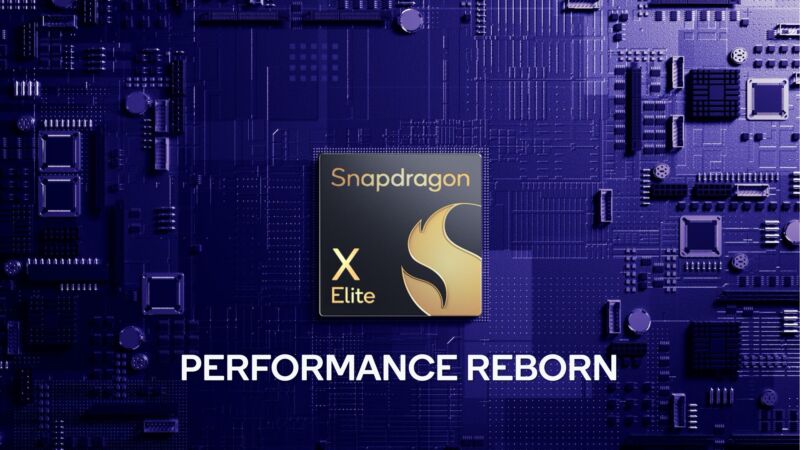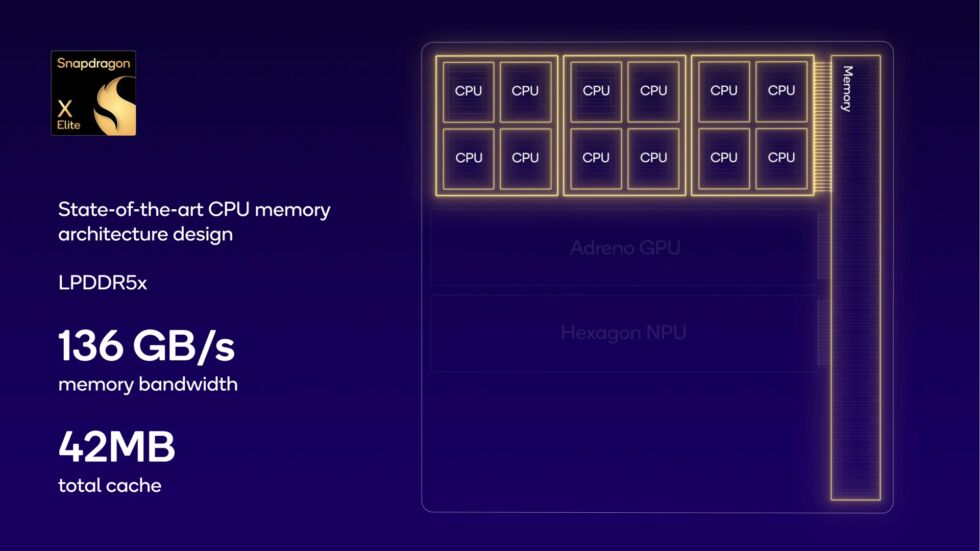
For years, Qualcomm has been making Snapdragon chips for Windows PCs, and for years, those chips' performance have failed to dislodge Intel's or AMD's chips to any significant degree. Its latest Snapdragon 8cx Gen 3 (and the closely related Microsoft SQ3) appears in just two consumer PCs, the cumbersomely named Microsoft Surface Pro 9 with 5G and Lenovo's ThinkPad X13s Gen 1.
But that may be changing. Nearly three years ago, Qualcomm bought a company called Nuvia for $1.4 billion. Nuvia was mainly working on server processors, but the company's founders and many of its employees had also been involved in developing the A- and M-series Apple Silicon processors that have all enabled the iPhone, iPad, and Mac to achieve their enviable blend of performance and battery life. Today, Qualcomm is formally announcing the fruit of the Nuvia acquisition: the Qualcomm Snapdragon X Elite is a 12-core, 4 nm chip that will compete directly with Intel's Core processors and AMD Ryzen chips in PCs—and, less directly, Apple's M2 and M3-series processors for Macs.
Qualcomm says the Snapdragon X Elite will begin arriving in PCs starting in mid-2024. The company has also announced a new Snapdragon SoC for smartphones, the Snapdragon 8 Gen 3.
Meet the Snapdragon X Elite

The star of the Snapdragon X Elite is its all-new custom CPU architecture, codenamed Oryon. The X Elite includes a total of 12 Oryon cores, rather than a mix of large and small cores like Qualcomm has used in past designs. When all cores are active, they can run at peak speeds of up to 3.8 GHz, though when just one or two cores are boosting they can go up to 4.3 GHz.
Qualcomm uses some Apple-esque performance charts to demonstrate the X Elite's performance and power efficiency; the company claims that the X Elite will run up to twice as fast as an Intel Core i7-1355U or Core i7-1360P at the same power level, or it can match their performance while using 68 percent less power. Qualcomm also says the X Elite can match the performance of a beefier Core i7-13800H using 65 percent less power—providing roughly the same multi-core performance at 30 W that the Intel chip provides at 90 W. The X Elite's power consumption appears to max out at around 50 W, and to go as low as 10 W, at least according to these charts.
-
Compared to ultraportable U- and P-series CPUs from Intel, Qualcomm says it can provide the same level of performance at around 18 W as Intel can at 50 W. At 50 W, Qualcomm says the X Elite can run up to twice as fast.Qualcomm
-
Compared to a higher-end H-series processor, Qualcomm says it can perform the same at 30 W as Intel does at 90 W.Qualcomm
-
Qualcomm's direct comparisons to Apple were relatively few and far between, but the company does say that the X Elite is about 50 percent faster than the M2 at peak performance in multi-threaded tests.Qualcomm
These manufacturer-provided claims should always be taken with a grain of salt, but if they're anywhere close to accurate it seems like the X Elite could be well-suited for both ultraportable PCs (like the ThinkPad X Carbon) and thin-and-light workstations (like a Dell XPS 15 or 14-inch MacBook Pro). Lower power consumption also means better battery life and lower temperatures, which should make fanless MacBook Air-style designs possible.
Qualcomm hasn't said whether it plans to launch any versions of the X Elite with fewer CPU or GPU cores enabled, though we'll presumably find that out once actual products start to launch.
Qualcomm spent most of its time comparing the X Elite's performance and power usage to Intel's rather than Apple's—which makes sense, since Apple is coming up on its third generation of Arm chips for Macs. But it's clear that Qualcomm has Apple Silicon in its sights, too.
Qualcomm says that the X Elite has "50 percent faster peak multi-threaded performance" than the Apple M2, based on a multi-threaded Geekbench 6.2 test. Qualcomm's charts imply a peak power usage of around 50 W for the X Elite, which suggests that Qualcomm can roughly match the CPU performance of Apple's M2 Pro or M1 Max at roughly the same power consumption—this would be impressive for a first outing. But remember that this is just one test that Qualcomm itself has provided and that Apple is gearing up to release M3-series processors on a new 3 nm manufacturing process, which ought to help Apple keep its power-efficiency edge.
Promoted Comments